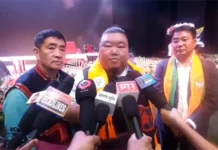[ Tom Simai ]
JAIRAMPUR, Sept 5: According to Wikipedia, in India, there are 191 languages classified as vulnerable or endangered, and Tangsa is one of the languages listed as vulnerable.
Multiple researchers of indigenous languages have asserted that the extinction threat looming over many Tangsa languages to be ‘very authentic and the day of disappearance might be closer than anticipated.’
Dr Stephen Morey, a linguist from LaTrobe University, Australia has been working on the conservation of Tangsa language since 2007.
Interacting with this scribe, Dr Morey expressed his apprehension by disclosing that by the close of the century, many Tangsa languages will disappear.
“The way things are going, most of the indigenous languages spoken today will be lost in the next 100 years,” Morey shared his trepidation.
“100 years from now, will anybody speak Tangsa languages? ‘Will there be people speaking Mossang, Kimsing, Tikhak, Ronrang, Tonglim, Langching, Lungchang, Muklom, Ngaimong etc,” Morey asked.
Highlighting one of the reasons pushing the indigenous languages towards oblivion, he said, “Hindi, English and Assamese are becoming the lingua franca of the young generation of indigenous people, which is driving them away from their rich dialects”.
“All across the world, traditional styles of singing and music are being lost. There is a great urgency to record, translate and understand the wide range of traditional songs – and my present research focus is on traditional songs of the Tangsa people,” he informed.
Morey recalled, “10 years ago, on 10 December 2007, I started my research work on Tangsa languages and recorded the first Wihu song sang by Lukam Tonglum. It was a mindboggling experience.’
The Wihu song is most important songs of many of the Tangsa / Tangshang group and it is connected with a traditional ritual held in the winter and is related to the traditional belief system of the Tangsa, involving the sacrifice of chickens and/or pigs to placate and thank the spirit of the earth.
“I was astounded and it took my breath away with its beauty,” Morey said adding, “This was the first time I heard the traditional song of Tangsa people and that night, around the fireplace, I recorded him singing this song”.
In order to conserve the indigenous languages, Morey suggested the documentation of Tangsa language by making a dictionary with as many words as possible. He also suggested recording of stories, songs, traditions, culture, etc as well as translating them so that everyone can understand the meaning of words and sentences.
Encouraging local involvement he said, “For an outsider like me, it took months to record the word list of nearly 2000 words, but the locals can achieve the same thing (recording story and song and translating it too) in a day or two.
“Tangsa languages are not only interesting but also complicated. At times, the work can be frustrating, but patience is vital to accomplish it,” he advised.
“As the Tangsa/ Tangshang people engage more and more with the modern world, the original context of Wihu songs is being lost. Many Tangsa people have converted to Christianity and the old rituals are hardly practiced,” he said.
“But this doesn’t mean that the song needs to be lost. For instance, in Burma, one Chung Mawn of the Rinkhu sub-tribe at Tarung village has composed new words that use both the poetics and tune of the Wihu song (Sahwi song), but the text tells the story of creation and the story of Jesus as found in the Bible,” he added.
Morey further said, “If we are going to have good records of all languages and dialects spoken today, we’re going to need to do a lot more work in the next few years”.
“And to accomplish such colossal task, we need everyone’s help,” he added.


